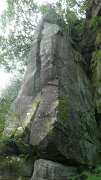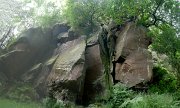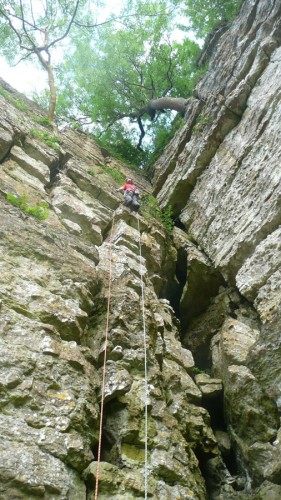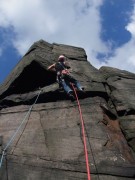 Ever since I first read about Guisecliff (almost 20 years ago!) I've meant to go there, but have somehow never made it despite its being less than an hour from York. It has a reputation for dirty, vegetated rock, as it faces north and trees grow right up to the foot of the crag, so its proximity to Brimham means I always end up there instead. The only person I know of who has climbed at Guisecliff pronounced it horribly dirty, and left without doing a single route!
Ever since I first read about Guisecliff (almost 20 years ago!) I've meant to go there, but have somehow never made it despite its being less than an hour from York. It has a reputation for dirty, vegetated rock, as it faces north and trees grow right up to the foot of the crag, so its proximity to Brimham means I always end up there instead. The only person I know of who has climbed at Guisecliff pronounced it horribly dirty, and left without doing a single route!
Anyway, I found myself on my own a couple of weekends ago, with time on my hands, so I thought I'd go and see if it was worth a proper trip sometime. The following might be of use to someone who's not been before.
 The guidebook recommends North Buttress (nearest the car park) for a first visit, but I decided instead to walk to the far end and then back along the crag, visiting each of the main buttresses as I went. Things didn't start well, as attempting to follow the guidebook directions to No 2 Buttress ('below the TV mast') led to a few small broken quarried rocks, with nothing even approaching the promised 20m cliffs. I eventually gave in and walked towards what I assumed would be No 3 Buttress – however, it turned out that No 2 isn't below the mast at all, but several hundred metres to the west, so I soon found myself at No 1 Buttress. This was surrounded by shrubbery, but had more clean rock than I had expected, and there were a couple of lines at least that looked worthwhile.
The guidebook recommends North Buttress (nearest the car park) for a first visit, but I decided instead to walk to the far end and then back along the crag, visiting each of the main buttresses as I went. Things didn't start well, as attempting to follow the guidebook directions to No 2 Buttress ('below the TV mast') led to a few small broken quarried rocks, with nothing even approaching the promised 20m cliffs. I eventually gave in and walked towards what I assumed would be No 3 Buttress – however, it turned out that No 2 isn't below the mast at all, but several hundred metres to the west, so I soon found myself at No 1 Buttress. This was surrounded by shrubbery, but had more clean rock than I had expected, and there were a couple of lines at least that looked worthwhile.
 No 2 Buttress was much better – far more rock than vegetation, and most of it relatively clean looking. Most of the obvious lines were far too hard for me (E2 to E6!), but one in particular that stood out was the massive chimney of Illusion – HS 4b and no stars, but just cries out to be climbed! I'd taken a rope and some gear, with a view to possible setting up a top rope and shunting some routes. However it quickly became clear that this was not practical, as finding the tops of the routes from above would be difficult and possibly dangerous, with lots of hidden crevasses. So instead, I set off to solo a route at the left end of No 2, called Letterbox Climb. No stars but described as 'worthwhile' – like most of the lower grade routes, the description has been copied unchanged from one edition to the next ever since the 50s, possibly because they haven't been reclimbed!
No 2 Buttress was much better – far more rock than vegetation, and most of it relatively clean looking. Most of the obvious lines were far too hard for me (E2 to E6!), but one in particular that stood out was the massive chimney of Illusion – HS 4b and no stars, but just cries out to be climbed! I'd taken a rope and some gear, with a view to possible setting up a top rope and shunting some routes. However it quickly became clear that this was not practical, as finding the tops of the routes from above would be difficult and possibly dangerous, with lots of hidden crevasses. So instead, I set off to solo a route at the left end of No 2, called Letterbox Climb. No stars but described as 'worthwhile' – like most of the lower grade routes, the description has been copied unchanged from one edition to the next ever since the 50s, possibly because they haven't been reclimbed!
Graded Diff in the guidebook, but it's surrounded by brackets to indicate it's not been checked in recent years. Of course I didn't let this put me off, nor the fact that it took a line up the most vegetated part of the buttress. I took some gear, and also dragged a rope up just in case. It turned out to be a good route, better than it looked, and the gear was handy to protect a couple of exposed sections. The top part, of which the guide simply says "climb the recess and go through the letterbox slot", was unprotected without large gear (which I didn't take). So I went round it onto the moor, almost fell down a hole, and set up a top rope which I then shunted. Very traditional at the grade, ie a bit of a sandbag – maybe VDiff 4a/b (easier for the tall).
 After this minor trauma, I carried on the walk along the base of the crag. The book suggests this is a bad idea due to dense vegetation and that approaches from the top are preferable, but since on the walk in I'd failed to spot most of the landmarks allegedly marking the descents I decided to go with the jungle bashing option instead. It turned out to be fine at first, with each buttress having a path (of sorts), and only the short sections between buttresses requiring care.
After this minor trauma, I carried on the walk along the base of the crag. The book suggests this is a bad idea due to dense vegetation and that approaches from the top are preferable, but since on the walk in I'd failed to spot most of the landmarks allegedly marking the descents I decided to go with the jungle bashing option instead. It turned out to be fine at first, with each buttress having a path (of sorts), and only the short sections between buttresses requiring care.
No 3 Buttress looked promising, but the left half (with the easier lines) was very dirty. A starred HS looked good but the guidebook description has said "needs cleaning" for the last 20 years, and I don't think anybody has bothered! The right half is clean, but steep and loose-looking. After this, it was quite hard work to reach No 4 buttress, but it's not far.
 No 4 Buttress includes the striking crack line of Roc's Nest Chimney (HS 4b), which demands to be climbed (though may currently contain an active kestrel's nest). But the once-starred corner of Dhobi (MVS) to the right is now green and mossy with a very large (empty) nest at the crux bulge.
No 4 Buttress includes the striking crack line of Roc's Nest Chimney (HS 4b), which demands to be climbed (though may currently contain an active kestrel's nest). But the once-starred corner of Dhobi (MVS) to the right is now green and mossy with a very large (empty) nest at the crux bulge.

No 5 Buttress started disappointingly, with Hawk Slab ("the best Severe on the crag") completely invisible behind the vegetation (though subsequent reading of old editions of the guidebook suggests I may not have been looking in quite the right place). But farther right, Jezebel (S **) looked pretty good, as did the adjacent VDiff, HVD, and VS.

Next came Comet Buttress, which contains two *** HVSs, a *** E4 and a *** E5. All looked a bit grubby so would need some cleaning (a stake at the top allows an abseil approach for this). As well as the abseil, another possible descent at this point is to down-climb Scissors (Mod). This area can be seen from the cliff-top path as a flat earthy platform standing out slightly from the main cliff.
The next section is The Long Wall, and here it became very slow and laborious to get along the foot of the crag. Unfortunately approaches from the top are also few and far between, but except for the E5 leader, there was very little to attract a return.
 The exception was Shelter Climb (Diff *), which I briefly tried soloing but decided it was too committing for a solo visit so backed off. Seemed good though, possibly VDiff but might have been easier if approached with confidence, something to go back for. Early editions of the guide suggests a start up the (now tree-shrouded) slab to the left of the cracks, however the cracks were rather good and a more obvious line.
The exception was Shelter Climb (Diff *), which I briefly tried soloing but decided it was too committing for a solo visit so backed off. Seemed good though, possibly VDiff but might have been easier if approached with confidence, something to go back for. Early editions of the guide suggests a start up the (now tree-shrouded) slab to the left of the cracks, however the cracks were rather good and a more obvious line.
Passing Needle's Eye Buttress (or possibly Needles High Buttress depending on guidebook), I'd been considering a solo of The Intestine (Moderate) which squirms up the back of a cave, but one look at the dripping orifice and I moved on. The 1956 guide grades this as "Moderate technically, but Severe on the nerves" so I'm quite glad I didn't bother! The intriguingly-named pinnacle of the Aiguille des Moutons (VDiff, "may seem hard for a short man") was just about visible through the trees above.
 Next comes North Buttress Block, which is very clean and very steep. I couldn't make out the line of The Chimney ("the obvious fissure on the left") so it's probably behind some trees, but Double Top (HVS 5a) looked particularly fine, and particularly hard! And a couple more E4s for the hard man.
Next comes North Buttress Block, which is very clean and very steep. I couldn't make out the line of The Chimney ("the obvious fissure on the left") so it's probably behind some trees, but Double Top (HVS 5a) looked particularly fine, and particularly hard! And a couple more E4s for the hard man.
The final area is North Buttress, which is the only one with a well worn track all the way there. Unfortunately, it was also by far the dirtiest, wettest, and least appealing on the entire crag. I suspect that this is one of the main reasons for Guisecliff's poor reputation – the buttress is the closest to the car park, the easiest to find, and is recommended by the guidebook for a first-time visitor. If I'd come here first, I  don't think I'd have gone any farther! There were several good-looking lines, but all were so filthy and/or vegetated that they'd require major cleaning before being climbable.
don't think I'd have gone any farther! There were several good-looking lines, but all were so filthy and/or vegetated that they'd require major cleaning before being climbable.
A few small isolated rocks and pinnacles remained, but all too short to bother anyone other than the dedicated boulderer.
The the best time to climb would probably after a short dry spell in the autumn. Summer (in theory) is warmer and drier, but also more humid, more verdant, and with more biting insects. Spring would be good, but is nesting season which could put quite a few areas out of bounds (there were raptors flying around at least 3 parts of the crag). A good hard winter could be an ideal time to visit some of the more vegetated parts of the crag!
Although the crag looks to be at its best for the mid-E grade climber with a sense of adventure (and willing to spend time cleaning/gardening/excavating the routes), there seems to be enough for mere mortals to justify at list one trip.
Some more pictures to put you off further are here.
 On a still and humid Tuesday evening Simon and myself headed to Peak Scar in an attempt to avoid the midges. Instead of midges we found ourselves battling through a flourishing sea of nettles, but at least it was a pleasant temperature. Unfortunately the tree clearance a few years back has opened up more light and space for the nettles – dread to think what they are like at Whitestone Cliffe at the moment.
On a still and humid Tuesday evening Simon and myself headed to Peak Scar in an attempt to avoid the midges. Instead of midges we found ourselves battling through a flourishing sea of nettles, but at least it was a pleasant temperature. Unfortunately the tree clearance a few years back has opened up more light and space for the nettles – dread to think what they are like at Whitestone Cliffe at the moment.






